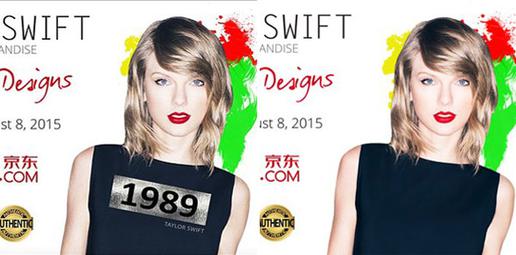When Iran’s cyber police accused Kim Kardashian of leading a Western-led infiltration operation, Iran’s models knew they were in trouble. The announcement came hot on the heels of news that one of the country’s biggest models, Elham Arab, had been forced to publicly denounce her profession. Prior to this, several fashion models had been arrested and their Instagram pages taken down.
Iran might take the cake for its adept and unpredictable censors. But before other countries get smug about it, let’s not forget that Iran isn’t the only country that tries to control its people by controlling fashion.
From Taylor Swift’s new clothing line to Lady Gaga’s shoes on TV, we look at fashion censorship around the world.
Taylor Swift: Wrong Birthday Unfortunate Initials

Fashion is usually about everything but fashion, as Taylor Swift found out last year. The award-winning singer launched a new clothing line in China in the run up to the tour for her album 1989 – named after the year of her birth. But for China, 1989 and the singer’s initials, T.S., are reminders of something the government would rather forget: the Tiananmen Square massacre, when thousands of innocent protesters were murdered. The event is heavily censored in China, so Taylor Swift may not be the Communist Party leader’s favorite pop singer.
So when China’s state media, CCTV News, ran an ad for Taylor Swift’s tour merchandise in July 2015, it made a few adjustments: the numbers “1989” suddenly vanished from sight, erased from tour T-shirts and nowhere to be seen on the Heritage66 website, Swift’s commercial partner tasked with promoting her products in China. It’s unclear who censored the images first, but the fact that it happened aptly illustrates just how intertwined politics and fashion are in China.
Maybe the late crooner Mel Tormé, whose initials are similar to Communist China’s founder Mao Tse-tung, would have an easier time promoting concerts in China.
Black Sharpie Censorship

Iran’s leaders are often driven by a need to imbue all aspects of culture and society with their particular brand of Islam. The Islamic hijab or the chador in Iran is a big part of this. So when fashion journals and magazines show women not conforming, it’s time for censors to get their black sharpies out. It’s a familiar scene across the Middle East, with advertisers and editors routinely turning to Photoshop to cover up threatening bare female flesh or unacceptable hijabs, ensuring they pass the country’s mullahs’ muster.
Magazines and ads from Saudi Arabia, Bahrain and Iran are mainly subject to “adjustments” prior to publication. In one Saudi issue of the women’s magazine Marie Claire, for example, censors used Photoshop to make dresses longer and more appropriate – from wedding dress features to pages dedicated to catwalks.
But when magazines and products are imported directly from the West, it’s often the shop owners who act as censors. One American blogger stumbled upon Katy Perry’s CD in a shop in Saudi Arabia, and noticed she looked a little different than usual. The owner had resorted to the so-called “black sharpie” method to change the artwork on the CD. Suddenly, Perry’s decadent swimsuit was a sexy full-body suit.
Some censors have better Photoshop skills than others. Iran’s Photoshoppers are known to be especially clever, and know just how to make women appear to conform with the country’s strict rules on female modesty. Sometimes they are so skilled that TV audiences and filmgoers would never even know. Even US first lady Michelle Obama got an Islamic makeover: At 2013’s Oscar awards ceremony, suddenly her glittery sleeveless dress had rather modest sleeves. It was done so well that the first lady might have approved it.
Lady Gaga’s Penis-Shaped Stilettos
It’s not just totalitarian regimes that censor. When pop singer Lady Gaga appeared as a guest mentor on Fox TV’s American Idol, her choice of stilettos did not go unnoticed. Lady Gaga isn’t known for her subtle outfit choices, but her stilettos with penis-shaped heels were too much, even for the Land of the Free. Producers responded quickly, slapping an American Idol logo across the footwear, or conveniently cropping them out of the screen altogether in order to protect viewers from such dangerous images.
Calvin Klein and the Fear of Nudity
Western countries have also been squeamish when it comes to fashion advertising. Back in the 1950s, for example, it was considered too inappropriate to show women wearing a bra on TV – even in a bra commercial. Advertisers were instead forced to sell their goods by showing a woman holding a sample of a bra while describing its virtues.
Since then, the boundaries of advertisement have changed, but ads continue to come under fire, even in countries that claim to be free of censorship. US fashion house Calvin Klein’s ads have a long history of getting on the wrong side of what the establishment and pressure groups believe is decent and acceptable. Since its early days of working with photographer Bruce Weber, CK has been repeatedly criticized for relying on sex and nudity to sell its products. In 2008, actress and model Eva Mendes’s nude commercial for a Calvin Klein perfume faced a ban by leading US television networks because it was considered to be too raunchy. In 2012, Australia’s Advertising Standards Bureau also banned a risqué Calvin Klein jeans campaign starring Dutch model Lara Stone.
“We have to take things down all the time. We get censored all the time,” Calvin Klein’s chief marketing officer Melisa Goldie said in an interview with The Drum in 2015. She implied that censorship of the fashion industry is rife everywhere in the world, and the US, which she described as "pretty conservative," is no exception.
Following the ban of her ad, Eva Mendes also criticized US censors. “I love my country,” she said, “but I believe that we are too quick to censor nudity. We seem okay with violence, but nudity we race to criticize and censor.”
Prada, American Apparel, and a slew of fashion brands have found themselves under scrutiny from advertising regulators around the world. Italy’s Institute for Advertising Self-Discipline banned a Tom Ford eyewear ad in 2008: the image of a woman wearing sunglasses with a man’s finger in her mouth was, according to the institute, “markedly vulgar” and evoked “an offending and abusive act against women, which degrades the dignity of the person.” Yes, this happened in a country whose former prime minister, Silvio Berlusconi, very soon after became famous for his Bunga Bunga parties. In May 2015, The UK’s Advertising Standards Authority banned a Miu Miu ad that appeared in the pages of Vogue UK, making the case that it “was likely to cause serious offence” because it was sexualizing a model with a “youthful appearance.”
The Church’s War on Benetton
Of course, it’s not only sex that causes offence. When advertisers attempt to coopt religion to sell fashion, it can often lead to trouble. In many countries, advertisers must shy away from sensitive religious issues if they want to avoid a ban.
In 2005, the French fashion house Marithe and Francois Girbaud recreated Da Vinci’s Last Supper, supplanting Jesus’s apostles with a group of well-dressed women. The ad was considered offensive to the Catholic religion, and banned by the city authorities in Milan, Italy. In France, the Catholic Church also won a court injunction to ban the ad. While a judge ruled the image to be “a gratuitous and aggressive act of intrusion on people's innermost beliefs,” lawyers for the fashion house said it was outright censorship. “It is a way of showing the place of women in society today, which is a reflection of our changing values,” lawyer Bernard Cahen said about the ad.
Italian clothing firm Benetton also faces regular criticism and calls for its ads to be banned. The 2011 ad campaign “Unhate” showed digitally altered images of political and religious leaders kissing. One image in particular – of the Pope embracing an Egyptian grand imam – caused controversy, and the Vatican quickly condemned the ads as being disrespectful. “This is a grave lack of respect for the Pope,” said the Vatican’s spokesman Father Federico Lombardi. The ad was pulled about an hour after the Vatican’s complaint. For its part, Benetton said the ads were supposed to foster tolerance and mutual respect.
The Shocking Pubic Hair on Instagram
Social media platforms including Facebook, Twitter and YouTube are blocked in Iran, but the photo-sharing application Instagram is still openly available. But to help stem the tide of inappropriate imagery and content, Iranian authorities have launched a so-called intelligent filter, restricting access to un-Islamic profiles and photos.
But Iranian authorities aren’t the only ones to control content on social media. In fact, censorship of Instagram is quite common – and the company itself has its own set of strict terms and conditions, opening up the possibilities for all sorts of interesting – and often debated – censorship decisions, especially around the subject of female nipples. Many celebrities, including Rihanna and Miley Cyrus, have posted topless photos on Instagram, only to find them taken them down again. Of course, Instagram only resorts to nipple censorship, if the nipples belong to a woman.
Instagram’s CEO Kevin Systrom has tried to sidestep his role in censoring nipples, blaming Apple’s strict guidelines on the types of content it allows on its app store. And nipples are not the only body part to have caused a row. In 2013, photographer and artist Petra Collins posted a photo of herself in a bikini from the waist down. Although she wasn’t showing any more skin than the millions of other bikini-wearing women who have posted their photos on Instagram, Collins did make the mistake of showing her pubic hair – a move that caused her entire account to be pulled down.
Collins later said Instagram’s decision to remove her profile “felt like a physical act, like the public coming at me with a razor, sticking their finger down my throat, forcing me to cover up, forcing me to succumb to society’s image of beauty.” For Collins, this was a clear example of how the “very real pressures we face everyday can turn into literal censorship.”
visit the accountability section
In this section of Iran Wire, you can contact the officials and launch your campaign for various problems






















comments